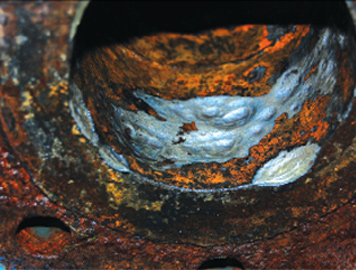Corrosion is a large and complex issue that is critical to the chemical process industries (CPI) as well as other industry sectors. Corrosion not only affects personal property like cars and homes but also affects commercial assets such as storage tanks, buildings, bridges, process equipment, and all types of piping. While corrosion is seen every day in our personal and professional lives, we rarely pause to understand the cause of the corrosion and, more importantly, how to mitigate it.
The most visible type of corrosion is generically called external corrosion. External corrosion has a range of causes from atmospheric corrosion to corrosion from stress corrosion cracking (SCC). Factors that cause external corrosion and the resulting problems that many engineers deal with everyday are generally well understood.
As an industry sector, the cathodic protection industry has developed an extensive range of design, testing and mitigation methods to help alleviate external corrosion. However, despite the expertise available to deal with corrosion, it costs the U.S. economy approximately $276 billion annually [1]. Included within this cost estimate are the effects of damage to infrastructure caused by internal corrosion.
Internal Corrosion
Many misunderstandings about internal corrosion persist, and in some cases, internal corrosion is dismissed as fiction and overlooked until problems occur (Figure 1). Although internal corrosion has been recognized and dealt with for many years, understanding of the problem and the science behind it continue to evolve.

Figure 1. Data must be gathered from a number of different sources to formulate a complete picture of the internal environment of an asset or system
Before internal corrosion can be effectively mitigated or controlled, the asset or system in question has to be evaluated correctly. This is where proper sampling procedures come into play. Data must be gathered from several sources to help formulate a complete picture of the internal environment of the asset or system.
Some of the data necessary to properly evaluate an asset or system include: material type, system contents, operating conditions, and, most importantly, analytical data. To obtain valid analytical data, proper sampling and handling techniques must be employed.
Sampling Methods
Internal corrosion sampling consists of several overlapping evaluation methods, some of which are performed with the asset or system operating normally, while other methods are performed with the equipment being operated specifically to facilitate the testing method. The most widely used methods for evaluating internal corrosion are the following:
• Bacterial analysis
• Coupons and probes
• Deposit analysis
• Gas samples
• Liquid samples
• Inline inspections
These sampling methods can be used independently, or in combination, to determine the extent and suspected causes of internal corrosion. This information can then be used to determine whether mitigating methods are necessary, as well as which sampling methods will be effective for determining whether or not the mitigation measures were successful.
Although there are generally many different assets and systems that are affected by internal corrosion, the sampling techniques used for gas and liquid pipelines can be adapted to work with virtually any other piece of equipment to obtain high-quality analytical data.
With the recent natural gas boom in several parts of the U.S., there is an increasing number of pipelines in place, and more are proposed for future installation. All of these pipelines could be affected by internal corrosion. With this resurgence of natural gas, along with the high-profile pipeline incidents that have occurred over the last few years, the need to understand and deal with any potential internal corrosion issues has never been greater. The situation makes proper sampling programs essential to any corrosion-management plan.
